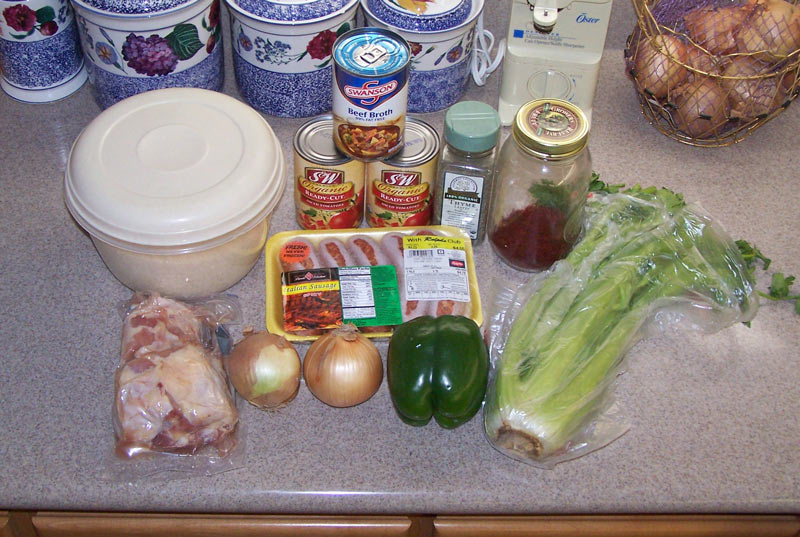
Making Creole Jambalaya
P. Michael Henderson
January 21, 2009
Jambalaya is a south Louisiana dish that developed from the Spanish paella. While paella is generally made with shell fish and seafood, Jambalaya can be made with many things, including shell fish and seafood. It's often made with leftovers. For example, if a family had a baked chicken for Sunday dinner, on Monday they would likely have chicken Jambalaya. If they were able to catch some river shrimp, they'd likely have shrimp Jambalaya.
I don't live in Louisiana any more, so I've had to adapt my Jambalaya to what's available to me. This recipe has proven to be pleasing to people of all ethnic backgrounds, but you can modify it to your particular taste.
The ingredients I used this time are as follows:
Chicken - about one pound, could be thighs, breast, or legs. [Update 5/3/2011 Instead of cooking the chicken myself, I've started buying one of the pre-cooked chickens at the local grocery store. I put it in the frig overnight and strip the meat off the next day.] [Update 2/15/2014 A good alternative to chicken is ham.]
Italian sausage - about one pound. I use the hot Italian sausage. Italian sausage is an important ingredient for this version of Jambalaya. You can delete many of the other ingredients, but not this.
Diced tomatoes - Two cans.
Beef broth
Two onions - one for cooking the chicken and one for the Jambalaya
Green pepper
Rice - I now use Uncle Ben's Converted rice (original) instead of regular rice. The Uncle Ben's maintains its shape and doesn't get mushy like regular rice can.
Celery for cooking the chicken
Thyme
Saffron
Here's the recipe put in "standard" form by my friend Carolyn Thurston, who writes the food blog "Tasting Spoons".
CHICKEN:
1 whole onion, chopped
3 stalks celery, chopped
1 pound chicken (thighs, breasts or legs)
JAMBALAYA:
2 T. olive oil
1 pound Italian sausage (hot or mild)
1 whole green pepper, chopped
1 whole onion, diced
32 ounces diced tomatoes, including juice
16 ounces beef broth
1 T. Thyme
¼ t. Saffron
2 ½ cups long-grain rice
1 pound frozen green peas (optional)
DIRECTIONS:
1. 1. In
a large pot place the chicken pieces, add the onion and celery, and then cover
with about 2 cups of cold water. Bring to a simmer and cook for about 20-30
minutes. If you’re using frozen chicken, add another 10 minutes to the cooking
time.
2. 2. Partially
freeze the Italian sausage to make it easier to slice. Cut all the sausage into
1/8 inch slices, but no thicker than ¼ inch.
3. 3. Dice up the
second onion and the green pepper and set aside.
4. 4. Once the
chicken is cooked, strain the stock and set it aside for later use. Some fat
will rise to the top – skim it off if you prefer to. You should have about 1 cup
of stock. When the chicken is cool enough to handle, remove all the meat and
discard any fat and bones. Break up the meat into small bite-sized pieces.
5. 5. In a large
skillet or pan heat the olive oil and add the sausage. Cook the sausage coins
until they’re golden brown. Push all the sausage to one side of the pan and then
add the onion and green pepper. Stir just the vegetable side (as best you can),
trying to keep the two sections separate. Once the vegetables are cooked to your
liking, mix in the sausage.
6. 6. Add the canned
tomatoes and their juice.
7. 7. Preheat oven to
350.
8. 8. To the pot add the
chicken stock and the chicken pieces, then the beef broth.
Bring it up to a low simmer. Keep track of exactly how much liquid you’ve
added, as you need to have 1 ½ cups of liquid (broth, water) for each cup of
rice you add. How much rice is up to you.
9. 9. Add dried thyme
(about 2-3 teaspoons) and about ¼ teaspoon of saffron threads. Taste the broth
in the pan to determine if you need to add salt and pepper. If you like hot
pepper sauce, it can be added at this time. Traditionally jambalaya is not a
spicy hot dish, so don’t overdo it.
10. Now add the rice. Heat the pan until the
liquid is just at a simmer, then cover pan and put it in the oven. You can add
peas to this if you’d like – they can be added now, or during the last 15
minutes of baking time.
1 11. Bake the jambalaya
for about 30 minutes. Check on it once – remove lid and taste the rice to see if
it’s done. If the pan has too much liquid in it, return to the oven but leave
off the lid. If the rice is not quite done but the liquid is all gone, add some
hot water to the pan and continue baking. Unless you stir the pot partway
through, the rice will fall to the bottom, so just dig down to find the rice to
test. [Update 2/15/2014 - I now like to leave some liquid in the jambalaya.
That is, I manage the liquid so that the jambalaya comes out fairly "wet".
By "wet" I mean that there will be liquid showing in the pan after the rice is
fully cooked. It just taste better to me than "dry" jambalaya].

The first thing we're going to do is prepare for cooking the chicken. I cut up one onion in large pieces and also cut up some celery in large pieces.

Put the chicken in a pot with the onion and celery and about two cups of water. Bring to a simmer and let it cook for about 20-30 minutes. If the chicken is frozen, add perhaps ten minutes. You can salt and pepper or wait and do it in the Jambalaya (I wait).
You can make jambalaya without chicken so you can skip this portion of the directions if you're not going to use chicken. Alternatively, you might have some left over chicken or turkey (perhaps from Thanksgiving or Christmas), so it'll already be cooked.
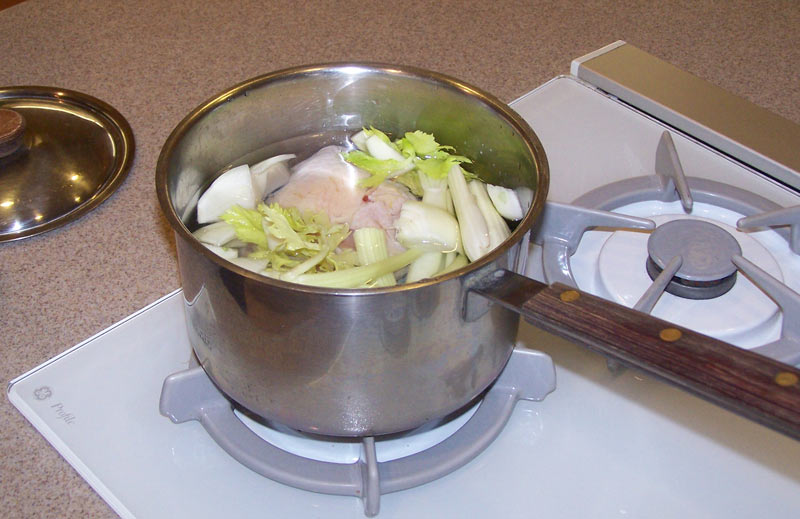
While the chicken's cooking, prepare the ingredients for the jambalaya. I freeze the Italian sausage to make it easier to cut. This allows me to cut the sausage thin, which is almost impossible when the sausage is at refrigerator temperature. When I cook with my wife, we always argue about how thick (or thin) to slice the sausage. I like it very thin and she likes it a bit thicker. I was cooking by myself here, so this is the way I prefer it.
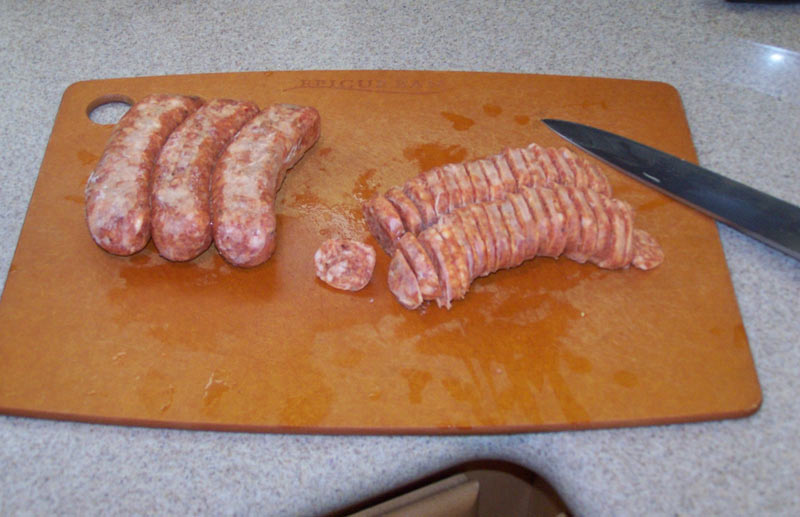
Then cut up the onion and green pepper.
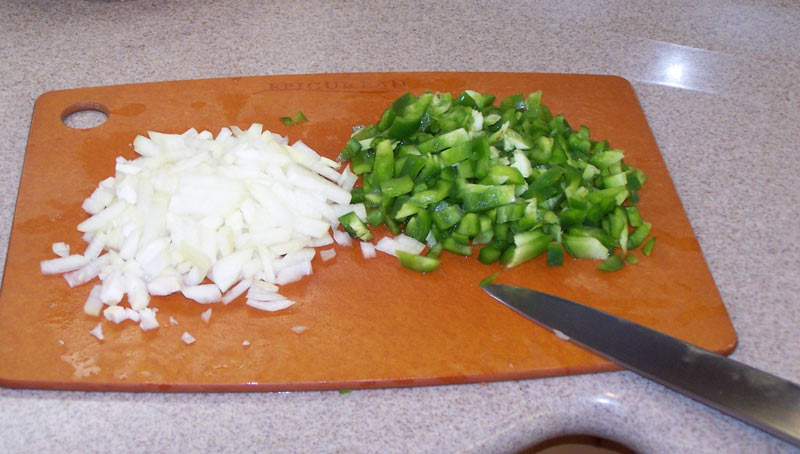
When the chicken is cooked, take it out of the pot and set it aside to cool. Strain the chicken stock and set it aside for later use in the Jambalaya. Some fat will rise to the top and you can skim that off, if you want to. You'll wind up with about a cup of stock.
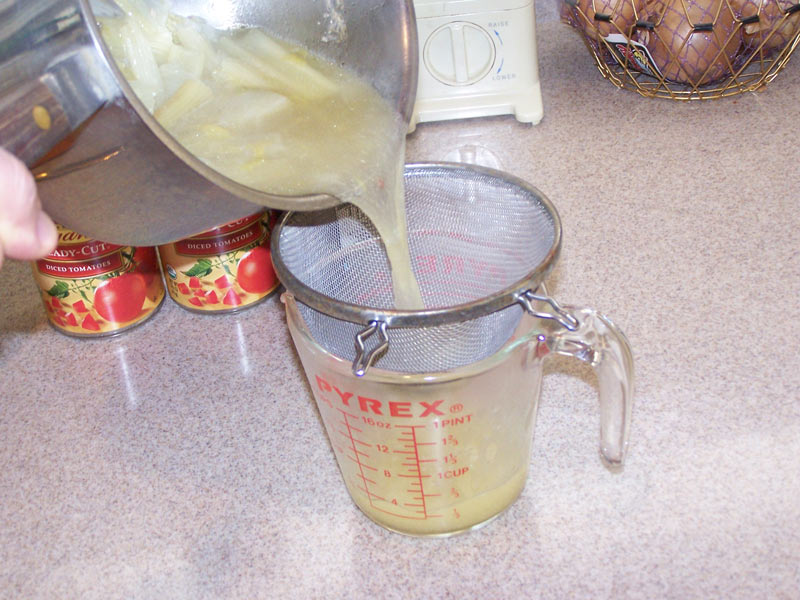
When the chicken is cool enough to handle, strip the meat off the bone. I like to break the meat into fairly small pieces.
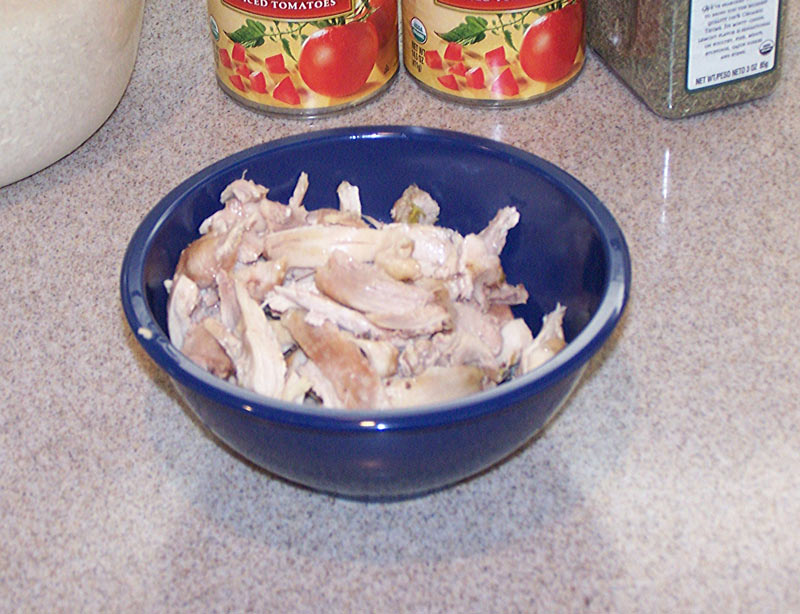
Okay, now we're ready to cook the jambalaya. I use a 12" pot that's about 3" high, with a cover. But the pot is not critical. I've seen jambalaya cooked in just about every pot imaginable. My mom used a cast iron Dutch oven most of the time.
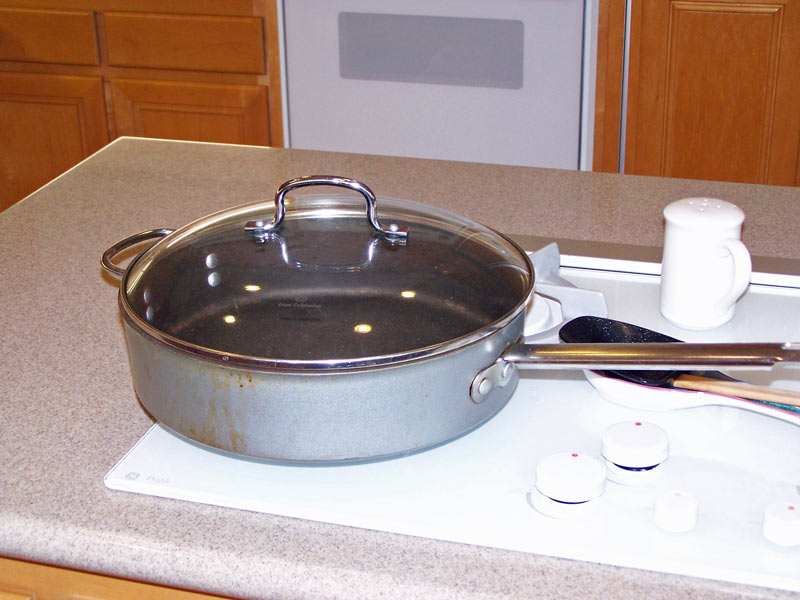
To start, I put a small amount of olive oil in the bottom of the pan and dump the sausage in.
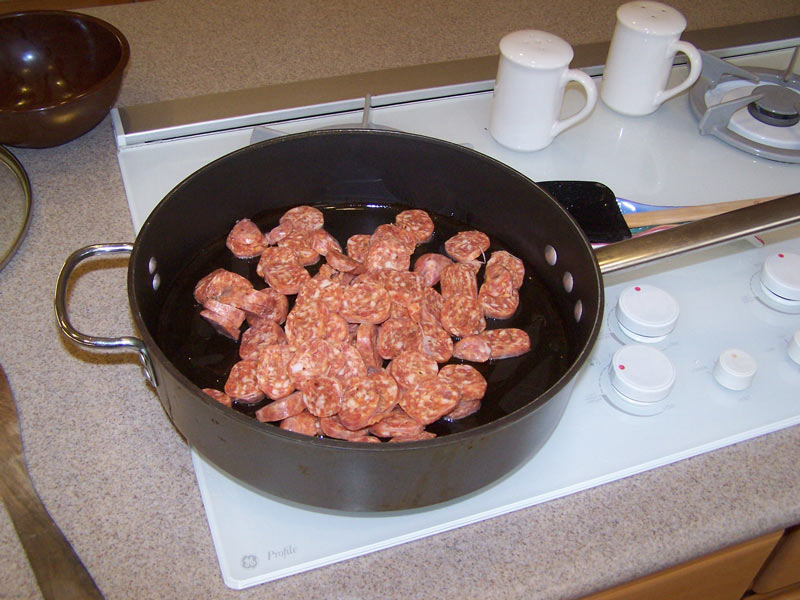
Cook the sausage until it's brown.
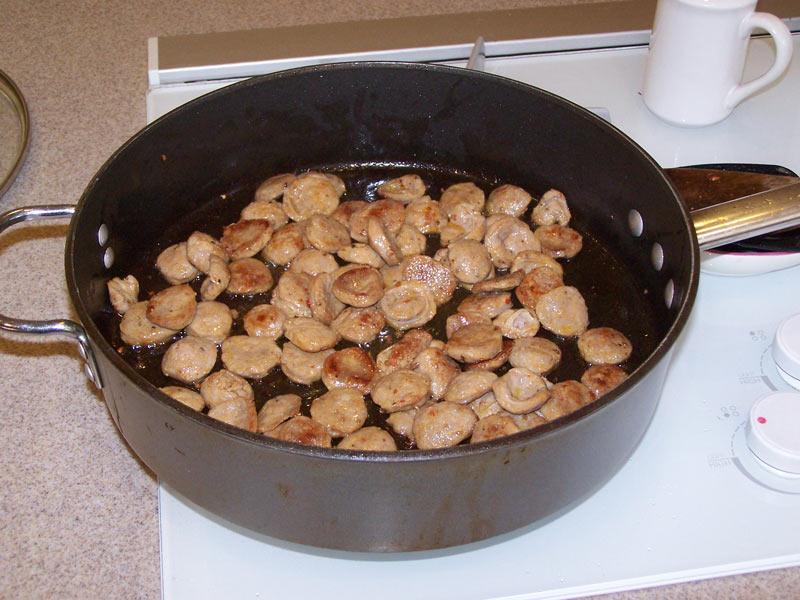
When the sausage is cooked to your liking, rake it to the side so you can add the onion and green pepper.
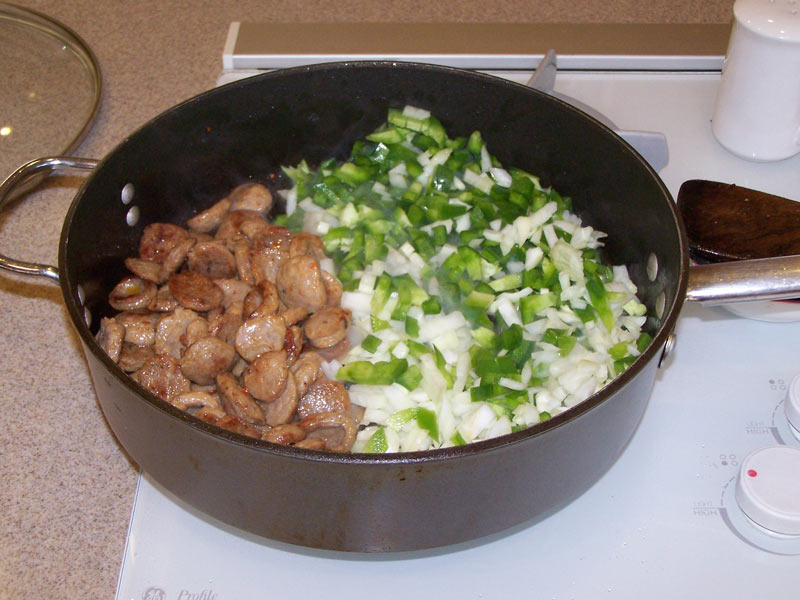
The sausage will continue to brown while you're sautéing the onion and pepper. Once the onion and pepper is done to your liking, mix it with the sausage.
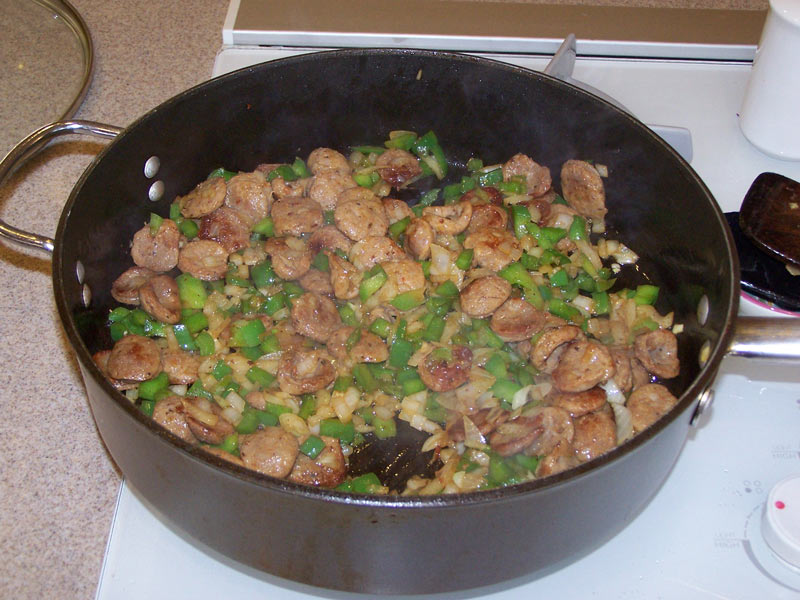
Now, add the tomato. I use two cans of diced tomato but you can use less (one can) if you prefer less tomato.
I'll explain later, but I finish cooking this in the oven so preheat your oven to 350 degrees now so it'll be hot later when we're ready to put it in.
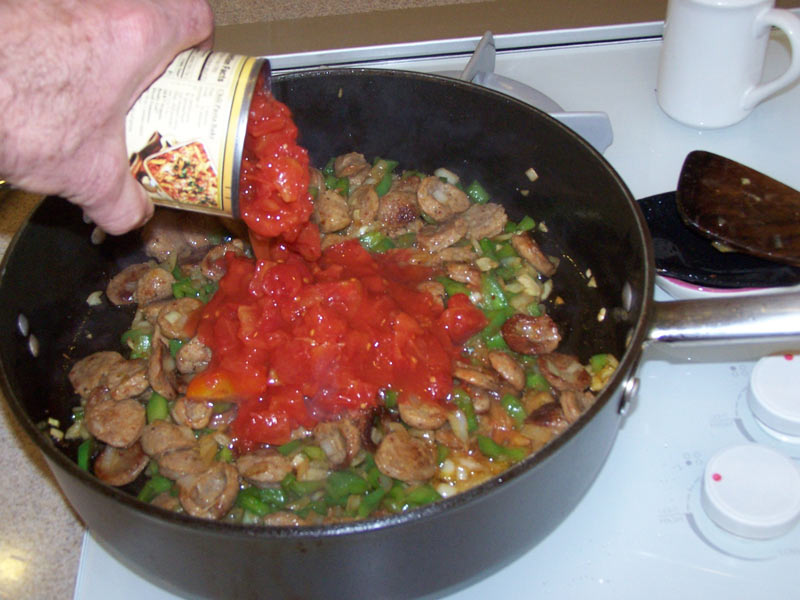
Then add your chicken stock.
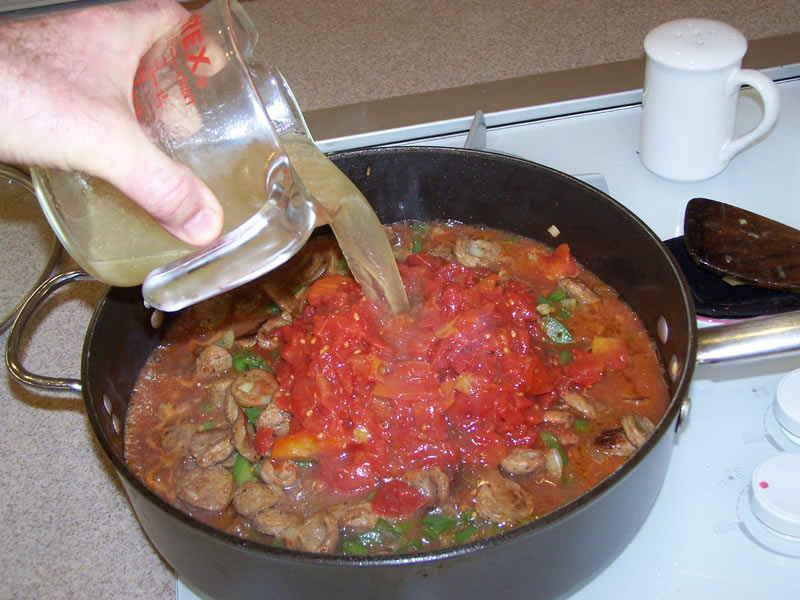
The chicken...
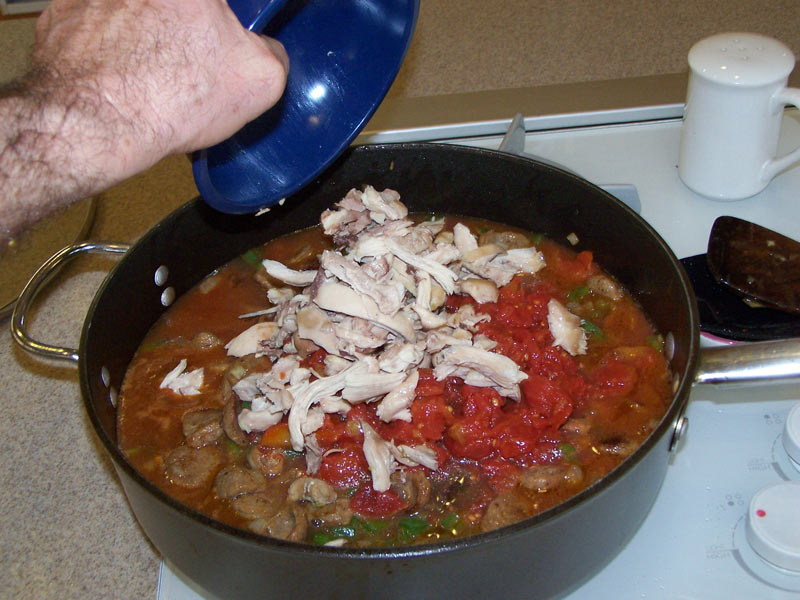
And add the can of beef broth. You need a lot of liquid to cook the rice, so I usually also add some water. If you keep track of your liquids, you need about 1.5 cups of liquid for each cup of rice. You can use chicken broth instead of beef broth, but I prefer the taste with some beef broth. Or if you don't like, or have, either, use water. [Update 2/15/2014 I now put about 2 cups of liquid in for each cup of Uncle Ben's rice. This will leave the jambalaya "wet".]
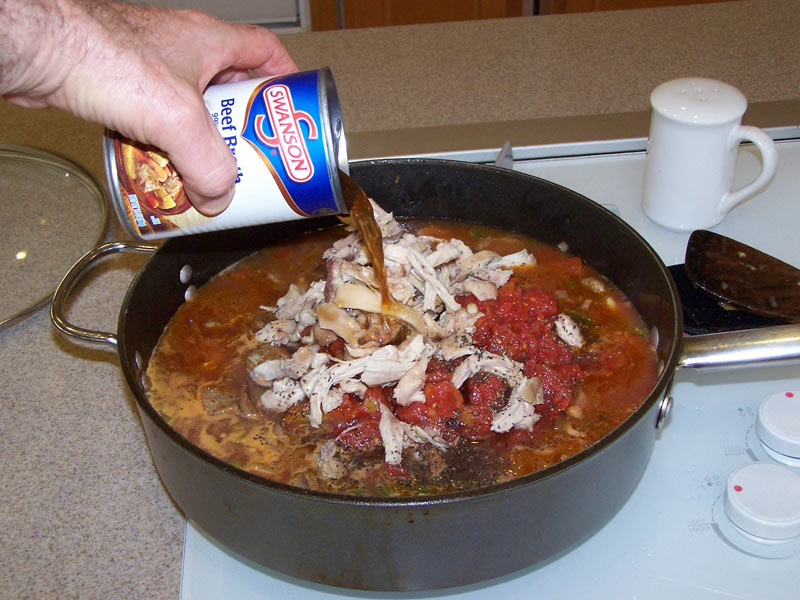
Add thyme, and saffron, then salt and pepper to taste. Just taste the liquid to determine how much salt is needed. If you like your jambalaya hot, you can add some hot pepper here. But don't go crazy. Traditionally, Jambalaya is not an exceptionally hot dish - just a touch.
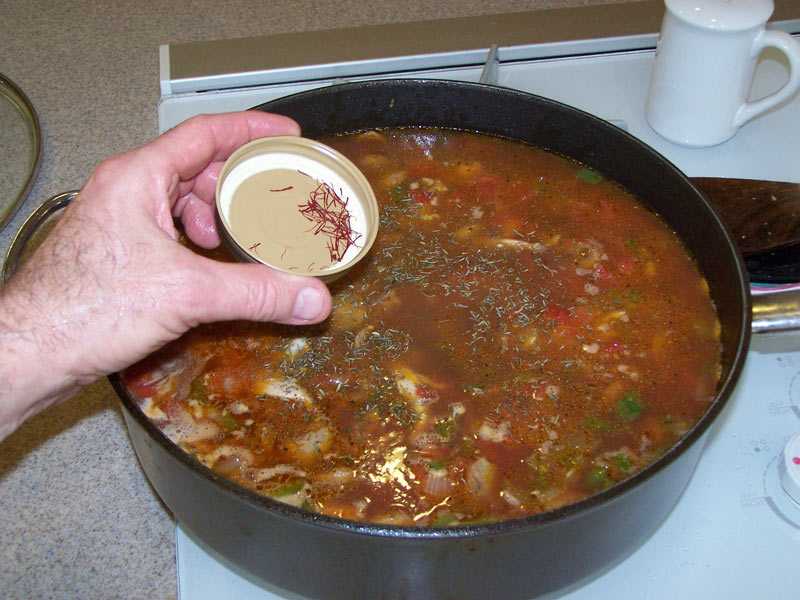
Now, add the long grain rice - (I now use Uncle Ben's converted rice because it doesn't get as sticky as regular long grain rice). I usually put about 2.5 cups in, but it depends on how many people you have to feed. If you've got a lot, just add more rice (and liquid). I'm sure that's what my mom did when I invited a friend to join us for dinner. [Update 2/15/2014 I now put less rice in the dish. Exactly how much depends on how many people I need to feed, but sometimes I only put one "full" cup of Uncle Ben's. "Full" means that a one cup measuring cup is filled to the top, which is more than a cup.]
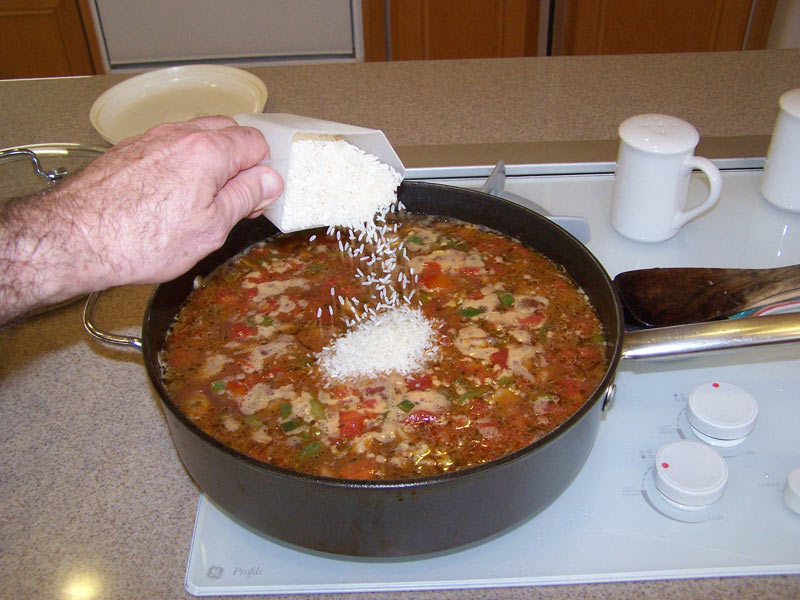
Now, this is very important - heat the liquid to a simmer before you put it in the oven. If you put it in the oven cold, the dish will heat from the outside-in. So the outside will cook while the center will be raw. Once you have the liquid to a simmer throughout the pan, cover the pot and put it in the oven.
You can certainly cook Jambalaya on the stove. You just have to cook it on a low heat because as the rice cooks, you'll burn the bottom if you have the burner set too high. It's just like cooking a big pot of rice.
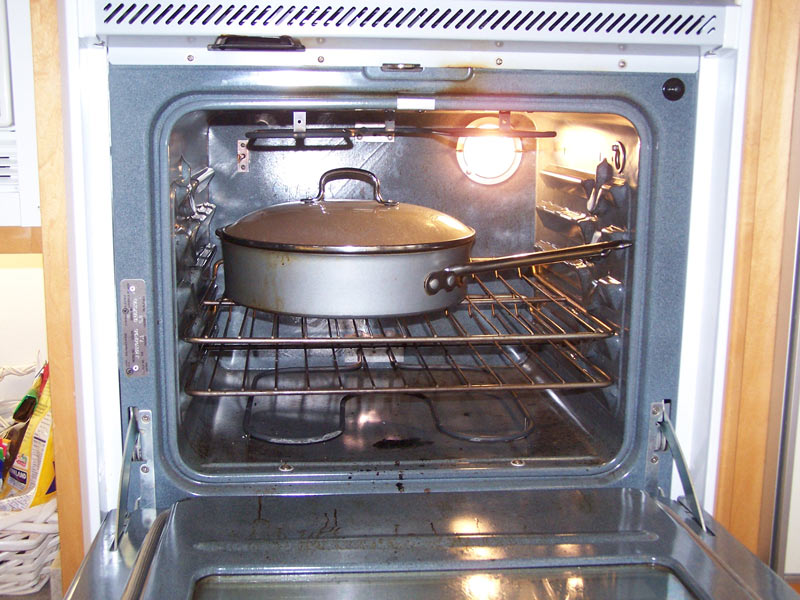
After I put the jambalaya in the oven, I decided to add some frozen peas (small peas), so I took the pot out - it was half cooked by then - and added the peas. You can see that the rice has started cooking but there's still a lot of liquid in the pot. If you want to add peas, do so before you put the pot in the oven. I just thought the peas would add color to the dish.
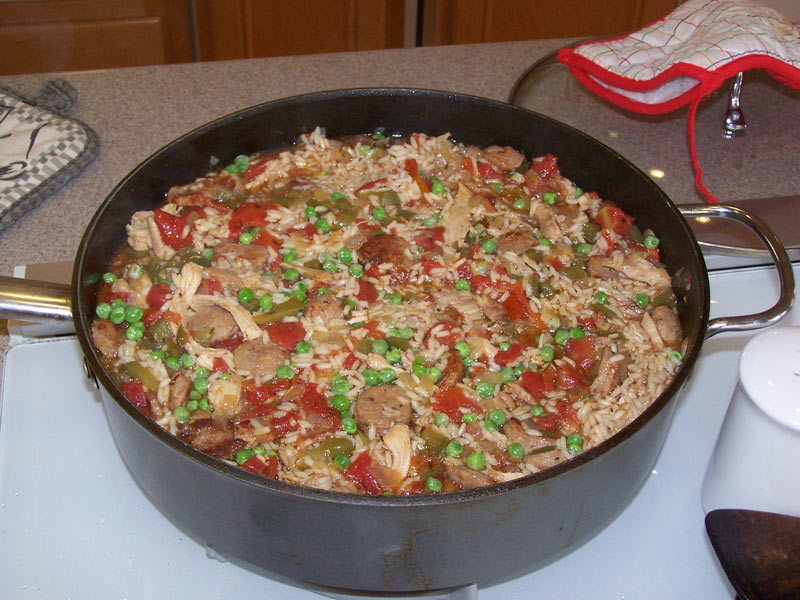
How long to cook? Got me. I just check on it every now and again by sticking a small spoon into the center of the dish to extract a small amount of rice. When the rice is cooked (not crunchy), the jambalaya is done. I think it usually takes about 30 minutes in the oven. If it looks like you have too much liquid, leave the top off. If the rice is too dry (crunchy), and the liquid is about all gone, add some water. [Update 2/15/2014 Try the jambalaya "wet" rather than the way I describe it here.]

And that's it. If you don't stir it (like I did to add the peas) you won't see as much rice on the top. The tomato and sausage will be on top and the rice will be below it. That's okay and is the way it should be.
You can also use a parboiled rice, like Uncle Ben's, which will give you a dish where the rice does not stick together as much as with raw rice.
But however you make it, I hope you enjoy it.
If you make Jambalaya from this tutorial, please let me know how it came out, and send me a picture. My e-mail is mike@mikes-woodwork.com
You can return to my woodwork here.
Side note on Jambalaya - there's two kind of Jambalaya in south Louisiana. Creole Jambalaya is made with tomatoes, as demonstrated here. Creole Jambalaya is native to the region around New Orleans (where I grew up). There's another kind of Jambalaya known as Cajun Jambalaya that's made without tomato. I don't know much about it, or how to cook it so I can't tell you much. I just wanted to let you know about the differences.